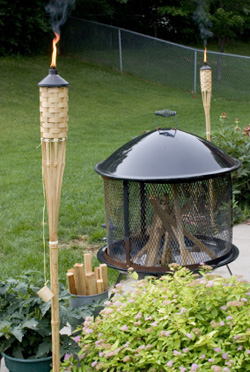Fire Extinguisher : 101
Garden Torch Candles and Fire Safety
| Home |
| About Fire Extinguishers |
| Using a Fire Extinguisher |
| Fire Prevention |
| Fire Hazards |
| First Aid for Fire |
| Financial Protection |
| Biggest Fires in History |
| Firefighters |
This site was voted:

by onlinefiresciencedegree.org
(scroll to 74 on the list)
This article is intended to provide individuals with general information pertaining to the dangers and fire risks associated with garden torch candles. |
Garden Torch Candles Defined
Garden torch candles are wax candles on a bamboo or wooden stake designed to be inserted into the ground or a bucket of sand. They are primarily used for outdoor lighting and decorative purposes.
A Potential
Fire Hazard
Late in 2005, the Ontario Office of the Fire Marshal (OFM) informed Health
Canada of the fire risk associated with garden torch candles. The concern
was recently raised again due to the increased availability and popularity
of these candles in the marketplace.
 Burn
tests conducted by the OFM and by Health Canada on several types of garden
torch candles confirmed that they present a significant fire risk to consumers.
The candle flame can ignite the support stake that is embedded in the
wax. Occasionally, burning pieces of the support stake break off and ignite
nearby objects. The stake can also crack, causing the candle to tip over
and ignite the surrounding area. In a particular case, the flaming wick
fell to the ground and continued burning even after the wax had been used
up. Dripping, splattering wax and very high flames have been reported
in regard to these types of candles. Garden torch candle fires can cause
not only significant property damage, but also serious burn injuries that
can result in death.
Burn
tests conducted by the OFM and by Health Canada on several types of garden
torch candles confirmed that they present a significant fire risk to consumers.
The candle flame can ignite the support stake that is embedded in the
wax. Occasionally, burning pieces of the support stake break off and ignite
nearby objects. The stake can also crack, causing the candle to tip over
and ignite the surrounding area. In a particular case, the flaming wick
fell to the ground and continued burning even after the wax had been used
up. Dripping, splattering wax and very high flames have been reported
in regard to these types of candles. Garden torch candle fires can cause
not only significant property damage, but also serious burn injuries that
can result in death.
Garden Torch
Candles Fire Safety Tips
Garden torch candles should only be lit outdoors. They should be placed
securely in an upright position in soft earth or a bucket of sand, far
from anything that can catch on fire such as plants, mulch, overhanging
branches, patio furniture, fences, buildings and all other types of structures.
Moreover, you should never group candles together, never move a candle
while it is lit, and avoid burning candles under windy conditions.If a
candle begins to exhibit any unusual burning pattern such as a high or
intensified flame, a crackling or shooting flame, you should immediately
put it out. Use a garden hose or bucket of water to extinguish it, or
smother the flame with a large snuffer, spoon or similar metal utensil.
Then, place the candle upside-down in a bucket of water. Candles should
be extinguished when only 50 mm (2 inches) of wax remains.
Regarding all types of candles, remember this:
- Never leave a burning candle unattended
- Place lit candles away from anything that is combustible.
- Keep burning candles out of the reach of children and pets.
Before importing or distributing candles, ask your suppliers to provide you with fire safety test results. If this information is not available, take initiative to have the product tested, or refrain from importing or distributing these candles.
Universal
Fire Safety Tips
Practicing fire safety drills on a regular basis can go a long
way towards preventing fire disasters. You should know exactly what to
do and where to go in the case of a fire; that is, know your escape route
beforehand. Develop a home escape plan for every member of your household,
or refer to your building's fire safety plan.
A smoke alarm should be installed on every level of your home - especially near sleeping areas. Every month, test the alarms by using a broom handle or cane to gently push the alarm test button to ensure their effectiveness. Make sure everyone can hear the smoke alarms from all areas of the house.
If you smoke, practice fire safety properly by always using a large, deep ashtray and completely extinguishing your cigarette butts. Never smoke lying down, if you are drowsy, or in bed.
If you cook, wear tight-fitting clothes and roll-up your sleeves. Do not reach over a hot burner. If a pot catches fire, cover it with a lid or dump salt on it, and turn off the burner. Play it safe and never leave your cooking unattended.
What
do I do if I catch on fire?
Lower yourself to the ground, cover
your face with your hands and roll over and
over to put out the flames. If you cannot do
this, grab a towel to smother the flames, or
wrap yourself up tightly in a blanket. Most
fire victims die from smoke, not flames. And
remember that smoke always rises, so it is imperative
that you get down on the floor and crawl on
your hands and knees to safety.
Written by
John Manley
Having experienced 2 house fires, John Manley now devotes some
of his spare time educating people about the importance of having fire
extinguishers, CO and fire alarms, and proper escape plans though the
website: Fire Extinguisher:
101 - www.fire-extinguisher101.com.